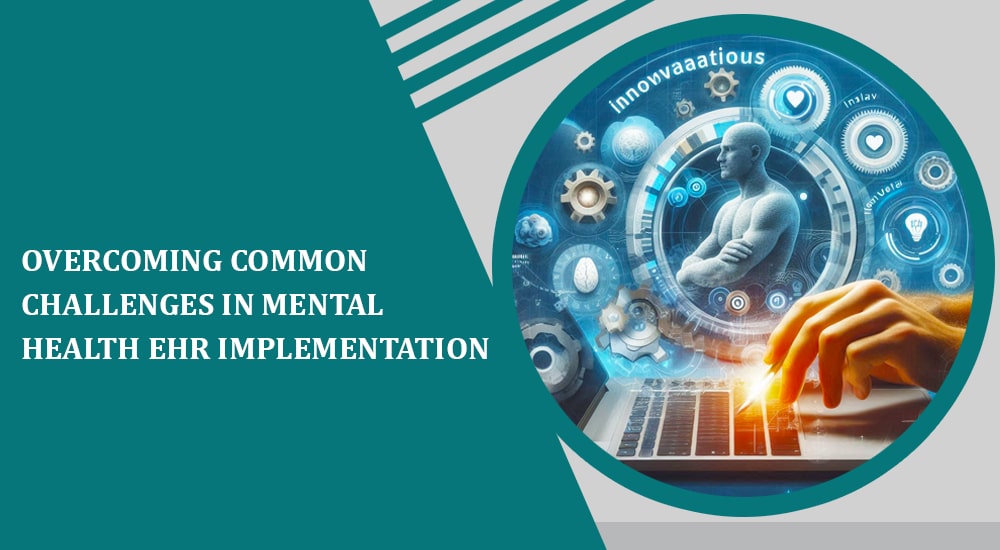
The implementation of Electronic Health Records (EHR) has transformed the healthcare landscape, particularly in mental health. While Mental Health EHR systems offer considerable advantages, such as improved patient outcomes and streamlined workflows, the path to successful implementation is fraught with challenges. For mental health professionals, the stakes are high, as these systems must cater to the unique needs of the field, including patient privacy, complex treatment plans, and multidisciplinary care teams. In this article, we explore common challenges in Mental Health EHR implementation and strategies to overcome them.
1. Data Migration from Legacy Systems
The Challenge:
One of the most immediate challenges faced during EHR implementation is migrating data from existing legacy systems. Many mental health clinics and institutions have been relying on paper-based records or older digital systems that lack interoperability with modern EHR solutions. The migration process can lead to incomplete or inaccurate data transfer, which may disrupt care continuity.
Solution:
To address data migration challenges, it is critical to conduct a thorough data audit and cleansing process before migration. This involves verifying the accuracy and relevance of patient records. Leveraging data migration tools that facilitate smooth integration and ensuring the new EHR system supports flexible data formats are essential steps. Additionally, working with a vendor experienced in healthcare migrations can help mitigate potential risks.
2. Ensuring Data Security and HIPAA Compliance
The Challenge:
Mental health records are especially sensitive due to the nature of the information they contain, such as therapy notes, psychiatric evaluations, and substance abuse treatment histories. Failing to safeguard this data can result in breaches of privacy and non-compliance with regulations such as the Health Insurance Portability and Accountability Act (HIPAA).
Solution:
EHR systems for mental health must be designed with robust security features, including encryption, role-based access controls, and two-factor authentication. Training staff on the importance of data privacy and regular HIPAA compliance audits can further enhance security. Choosing an EHR provider that is HIPAA-compliant and offers comprehensive security protocols ensures that the system adheres to the necessary legal requirements.
3. Training and User Adoption
The Challenge:
User adoption is one of the most frequently cited barriers to successful EHR implementation. Many mental health professionals are accustomed to using paper-based systems or less complex digital tools. The transition to a new system can be daunting, especially if users find it difficult to navigate or if it requires extensive training.
Solution:
Implementing a phased training approach can ease the learning curve for clinicians and staff. Hands-on training sessions, video tutorials, and ongoing support from the EHR vendor can help users become proficient with the new system. Engaging early adopters or “super users” who can champion the benefits of the EHR and provide peer-to-peer support can also accelerate adoption. Additionally, selecting an intuitive and user-friendly interface will increase the likelihood of smooth adoption.
4. Customizing EHRs for Mental Health Needs
The Challenge:
Mental health practices often have different documentation and workflow requirements than other medical specialties. Standard EHR systems may not offer the flexibility needed to accommodate the complexities of mental health care, such as tracking detailed therapy notes, treatment plans, and progress assessments over time.
Solution:
The key to overcoming this challenge lies in selecting a mental health-specific EHR system or one that offers customizable workflows. Customization options should allow for tailoring of templates, forms, and care pathways. Collaborating with the EHR vendor to design specific workflows that meet the unique requirements of mental health services ensures that the system aligns with the needs of the practice.
5. Cost and Financial Considerations
The Challenge:
Implementing an EHR system is a significant financial investment, with costs including software licensing, hardware, staff training, and potential disruptions to the practice during the transition phase. Smaller clinics and practices, in particular, may struggle with the financial burden associated with EHR implementation.
Solution:
Financial planning and securing appropriate funding sources are critical for addressing this challenge. Practices may explore government incentives and grants, such as those offered under the HITECH Act, to help offset implementation costs. Additionally, negotiating with EHR vendors for flexible pricing models, including subscription-based plans or pay-per-user schemes, can make the investment more manageable. It is also important to weigh the long-term financial benefits of the EHR, such as improved billing accuracy and reduced administrative costs.
6. Integrating with Other Systems
The Challenge:
Interoperability is a major concern in mental health EHR implementation. Mental health care often requires coordination with external healthcare providers, insurance companies, and social services. A lack of interoperability can lead to fragmented care and duplicated efforts, hindering the overall efficiency of the system.
Solution:
When choosing an EHR system, prioritize one that offers interoperability with other healthcare systems, including primary care EHRs, lab systems, and pharmacies. Ensuring that the EHR adheres to healthcare data exchange standards, such as HL7 or FHIR, allows for seamless communication between systems. Integrating with health information exchanges (HIEs) further enhances data sharing and care coordination across different healthcare providers.
7. Maintaining Workflow Efficiency During Transition
The Challenge:
One of the biggest fears clinicians have is that transitioning to an EHR system will disrupt existing workflows and lead to decreased productivity. This is particularly concerning in mental health, where maintaining the flow of patient care is critical.
Solution:
To minimize workflow disruptions, it is beneficial to gradually phase in the EHR system rather than launching it all at once. Start with basic functionalities and expand over time, allowing staff to adjust gradually. Simulations and test environments can be used to help users practice using the system without impacting patient care. Regular feedback sessions during the transition period can also highlight areas where the workflow can be improved.
8. Overcoming Resistance to Change
The Challenge:
Resistance to change is a common psychological barrier in any technological adoption process. In mental health practices, clinicians may feel that an EHR system impedes their personal connection with patients or that it adds unnecessary complexity to their work.
Solution:
Clear communication about the benefits of the EHR, both for the practice and for patient care, is essential in overcoming resistance. Involve clinicians and staff in the selection and customization process to ensure they feel heard and invested in the change. Demonstrating how the EHR can improve clinical outcomes, such as by providing easier access to patient history and enhancing treatment planning, can also help shift attitudes in favor of adoption.
Conclusion
Implementing a Mental Health EHR system comes with its unique set of challenges, from data migration to customization needs and cost concerns. However, with strategic planning, clear communication, and the right technology partner, these obstacles can be overcome. The benefits of improved patient care, streamlined workflows, and enhanced compliance far outweigh the initial difficulties. By addressing these common challenges head-on, mental health providers can harness the full potential of EHR systems to deliver better care for their patients.





